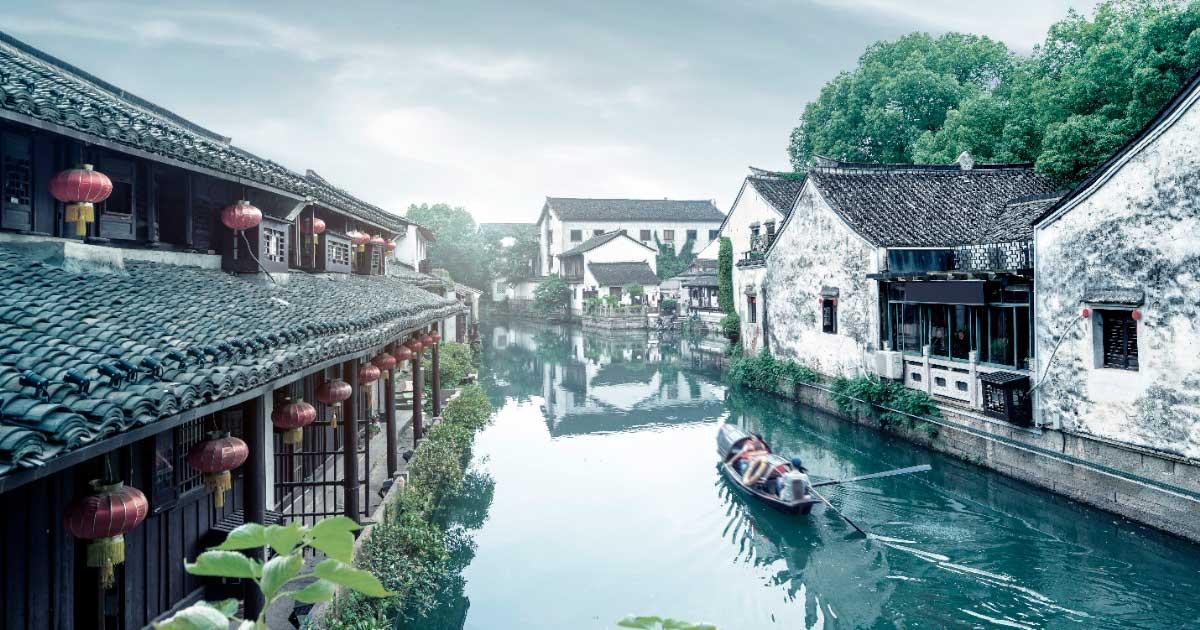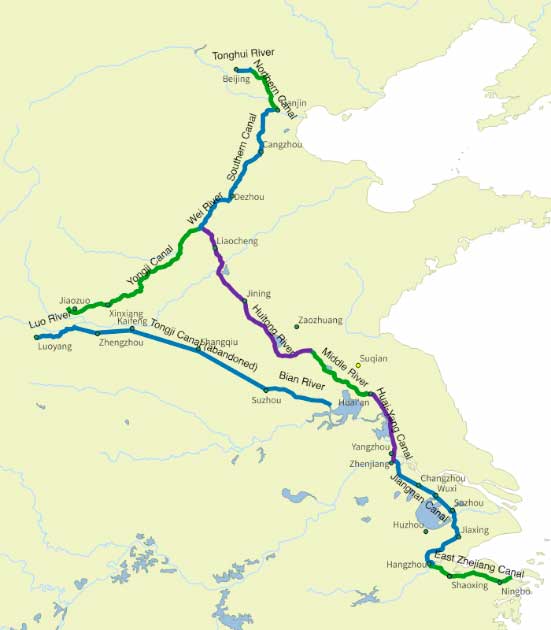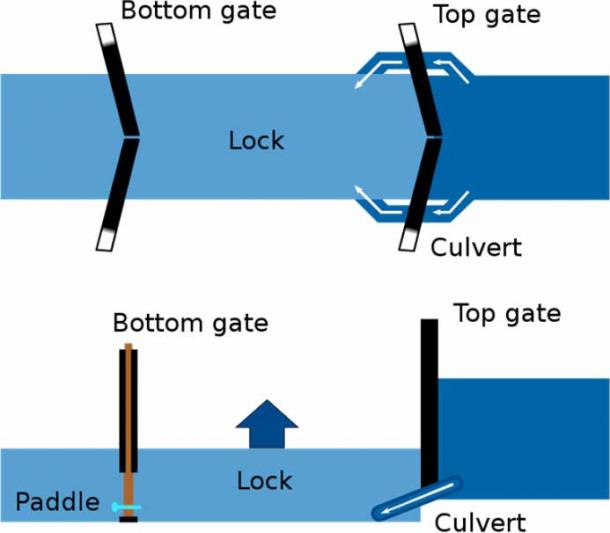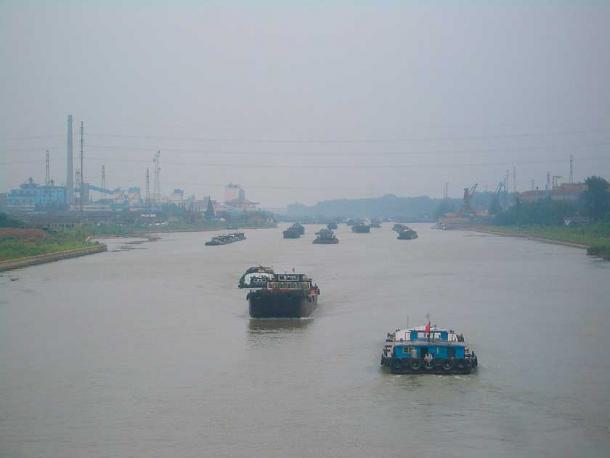
The 2500-year-old Genius of China’s Grand Canal System
Ancient China is known for its famous dynasties, rich culture, and some of the first “advanced” technological innovations in the world. One of the best-known works created in ancient China is China’s Grand Canal, a manmade waterway that still links several Chinese cities for trade and travel. In fact, China’s Grand Canal is the longest manmade waterway in the world, reaching just over 1,100 miles (1,770 kilometers) in length!
Though China’s Grand Canal is still used for trade and transport today, how it was first built and developed is historically fascinating in many regards. In this article, we’re going to go through exactly what the canal is, what it does, and why it was built.
China’s Grand Canal: A Genius Waterway Masterpiece!
China’s Grand Canal, known in China as the Jing-Hang Grand Canal, is the longest canal in the world. The canal links the Yellow and Yangtze rivers, passing through the provinces of Shandong, Jiangsu, Zhejiang, and Hebei. It begins in Beijing and ends in Hangzhou and is “officially” 1,104 miles (1,776 kilometers) in length. The canal’s maximum height is 42 meters (138 feet), in the high mountains of Shandong, where a pound lock is used to raise or lower the ships in the water.
China’s Grand Canal essentially reunified and connected North China with South China, via two of the country’s biggest rivers, and formed the basis of a sophisticated all-China trade network. Once the canal was built, it was much easier for grain in the south to be transported to the north, where most Chinese political and military leaders resided.
In times of war, the canal was used as a Chinese defense mechanism against enemy troops. In some locations, such as along the Yellow River, dikes that normally held back water were destroyed to cause massive canal flooding around the canal to “wash” away enemy troops and protect Chinese forces upstream.
- Buried Roman Canal and Road Unearthed in the Netherlands
- Ingenious Pre-Incan Hydrologic System Could Stabilize Modern Water Supply in Peru
Historically, Lake Lianhu has fed water into the canal near its Jiangnan opening. Because the canal is man-made, water must be manually fed into the waterway so that the water is high enough for bigger ships to pass through. Lake Lianhu is a manmade lake that was built to feed the canal the water it needed.
The lake was protected against exploitation for many years, though protections dwindled over the centuries as different governmental entities changed protection laws regarding the lake. Now, the lake is too shallow to feed the canal and is used exclusively as a recreational spot. Locals hope that increased interest in the lake will result in its restoration as a source of water for the Grand Canal.
Throughout history, the Grand Canal has provided protection and increased access to goods for the Chinese people. Because of this increased access to goods, the Grand Canal has long served as key transport system in China’s economy. Trading that was once laborious and time-consuming is now significantly faster thanks to the canal, which is still in use for the transport of bulk materials and large containers on barges between north and south China. Shipped goods frequently include coal, gravel, diesel, sand, and construction materials.
The construction of the Grand Canal has also impacted the surrounding land over the years. Because of increased access to water, land adjacent to the canal is extremely fertile, which has significantly improved agriculture in the area over the centuries. Agricultural harvests from these lands were then shipped across the country via the canal, making the region a self-sustainable economic region.

China’s Grand Canal during the Sui and Tang dynasties. (Groverlynn / CC BY-SA 4.0)
The First Section of China’s Grand Canal Dates to 468 BC!
The history of China’s Grand Canal can be traced all the way back to 468 BC. Though this was when the canal was originally built, it went through several renovations and enlargements over the centuries until it became the massive waterway system of today.
In its first year, Fu Chai, the king of the state of Wu, commanded his men to dig the Hangou Canal, which was the first step toward creating China’s Grand Canal. King Fu Chai wanted a simpler way to transport supplies north in case he needed to go to war with the states of Song, Lu, and others. And for this reason, the Hangou Canal was connected to the Huai and Jiang rivers. Once this section of the canal was completed, an additional canal, the Dagou canal, was dug sometime after 475 BC to connect the He and Ji Rivers. When these two initial sections were finished China’s Grand Canal connected to four major rivers, the Huai, Jiang, He, and Ji.
The first two sections of China’s Grand Canal, in Zhejiang and southern Jiangsu, were mostly built during the Sui dynasty (581–618) during a massive migration period from the Yellow River basin in the north to the southern region of China. Though political power remained in the north, the south became increasingly more affluent from the migrants who farmed the south’s highly fertile lands. Therefore, the first sections of the canal were first and foremost a fast way to get food from the south to the north.
The Grand Canal worked as expected until about 600 AD, when silt buildup on the bottom of one of the canals started to cause problems. Barges found it harder and harder to float through these canal chokepoints and eventually couldn’t get through. As a result, the old silt-clogged canal was abandoned for a new canal that ran parallel to the old one.
- Ancient Canals in Arizona Show Signs of Advanced Engineering
- The Sui Dynasty: 37 Years, Two Emperors and One Grand Canal
Emperor Yang of the Sui dynasty ordered the Suitang Grand Canal to be expanded further. He organized about 3.1 million slaves and criminals to do the work. This construction stage improved the Hangou Canal and also produced three entirely new canals within seven years. The new canals were the Yongji Canal, Tongji Canal, and Jiangnan Canal. It is estimated that 2.5 million of the canal construction workers in this phase died from overwork and disease.
The Sui dynasty Yang canal system connected Luoyang and Hangzhou until the 13th century, when work on the system continued. Years later, the Yongji Canal was used to transport Chinese troops during the Goguryeo-Sui Wars on the Korean Peninsula.

China’s invention of the water-level-adjusting pound lock in the 10th century AD made it easier for bigger barges to navigate rougher sections of China’s Grand Canal. (Nommonomanac / CC BY-SA 3.0)
Along with the canals, the Sui Dynasty took advantage of this new, fertile land and introduced a courier system. An imperial roadway and several post offices were built to aid in transporting goods from the south to the north. Dikes were also built along the Yellow River, which eventually led to the creation of canal lock gates, which could be used to raise water levels to help ships avoid becoming stuck in low waters.
The Tang dynasty (618-906 AD) “inherited” huge benefits from the Sui dynasty Grand Canal expansion. During the Tang dynasty, Yangzhou became a prosperous and thriving city thanks to its proximity to the canals and became the center of China’s biggest economic region. And as the cost of transporting grain, because of the canal, steadily decreased other goods also started to “travel” along China’s Grand Canal.
Unfortunately, all good things must come to an end. Due to the An Shi Rebellion in the 8th century, China’s economy took a downfall. Significant wars and flooding put a financial strain on the country and the canal system. In fact, the floods were so immense that thousands in the south perished. In response, Yangzhou was replaced by Kaifeng as the most stable city in China and was even made the capital during the Song Dynasty a few decades later.
During the Yuan Dynasty (1271-1368), the Grand Canal was again expanded. The capital of China had moved to the area of present-day Beijing, and access to Kaifeng was no longer a necessity. A new canal was built between the Sishui River and Weishui River, and another between Dadu (now Beijing) and Tongzhou. It was this connection that inspired the canal’s next grand name, the Jing-Hang Grand Canal (aka, Beijing, and Hangzhou). This project took over ten years to complete and required more than four million slaves. The manmade canals or rivers that were “created” in this phase included the Jizhou River, the Huitong River, and the Tonghui River.
After the latest additions to China’s Grand Canal some of the older canals were abandoned and were not improved until the 15th-century Ming dynasty. The Ming emperor, Yongle, learned that grain transportation had become increasingly slower and harder and decided to restore and renovate all the older canals with the aid of 165,000 laborers. Once restored, China’s Grand Canal brought significant economic prosperity back to its nearby cities.
Though the Ming dynasty restoration helped for many years, issues arose once again in the 18th and 19th centuries due to frequent Yellow River flooding. At one point, it flooded so much that the river changed its course entirely, rendering the Shandong canal useless.
Many of these canals once again fell into disaster, with some even becoming flat land again. In the 20th century, the People’s Republic of China called for reconstruction of the canal, which was granted. The water was restored in the 1990s from its polluted state, and work on the canals is still ongoing, though many of these ancient waterways are operating again.

Barges on a modern section of China’s Grand Canal (the "Li Canal" section) near Yangzhou, China. (Vmenkov / CC BY-SA 3.0)
A Fascinating Work In Progress
As mentioned previously, China’s Grand Canal is still functioning today. While it is not currently being used as a defense mechanism, it is certainly being used to transport bulk materials on barges, which provides both north and south China with the goods they need for many aspects of daily life. In addition to this, only the portion between Hangzhou and Liangshan County is currently navigable, with the other sections are blocked off. Modern routes typically have seven stops: the Jiangnan Canal, the Li Canal, the Lu Canal, the South Canal, the North Canal, the Tongui River, the Inner Canal, and the Middle Canal.
- Hydrologic Engineering Marvels Hidden in History
- 2000-year-old Canals Give Life to Lima as Ancient Structures Utilized to Solve Water Crisis
Nowadays, China’s Grand Canal is UNESCO World Heritage Site. It was added to the list in 2014 due to its historical, cultural, and technological value to China. Currently, the plan is to complete restoration work on the canal through 2030 to preserve this incredibly long landmark for years to come. Additional construction is also being undertaken on the South-North Water Transfer Project, which aims to bring more clean water to northern China from the Yangtze River. If you ever find yourself in China, be sure to check out this incredible canal and learn more about China’s rich culture.
Top image: The waterway wonders of China’s Grand Canal are both picturesque and ancient in some sections but also super modern and unattractive in others. This part of the canal is in the ancient, preserved section of Shaoxing, Zhejiang, China. Source: gui yong nian / Adobe Stock
By Lex Leigh
References
Encyclopedia Britannica . 1999. Grand Canal. Available at: https://www.britannica.com/topic/Grand-Canal-China
History.com. 2017. Tang dynasty. Available at: https://www.history.com/topics/ancient-china/tang-dynasty
Pang, K. 2021. Grand Canal in China, Da Yun he. China Highlights. Available at: https://www.chinahighlights.com/travelguide/culture/grand-canal.htm#:~:text=History%20of%20the%20Grand%20Canal,(1271%2D1368)%20respectively.
Tan, X. 2020. The technical history of China's Grand Canal. World Century Publishing Corporation.
Technological Solutions Inc. n.d. Ancient China - The Grand Canal. Ducksters. Available at: https://www.ducksters.com/history/china/grand_canal.php
UNESCO World Heritage Centre. 2014. The Grand Canal. UNESCO World Heritage Centre. Available at: https://whc.unesco.org/en/list/1443
Water Technology. n.d. South-to-north water diversion project. Available at: https://www.water-technology.net/projects/south_north/
Wei, G. 2014. UNESCO lists China’s Grand Canal as World Heritage Site. Global Times. Available at: https://www.globaltimes.cn/daily-specials/grand-canal-world-heritage-list/index.html#:~:text=China's%20Grand%20Canal%20was%20inscribed,annual%20session%20in%20Doha%2C%20Qatar.















